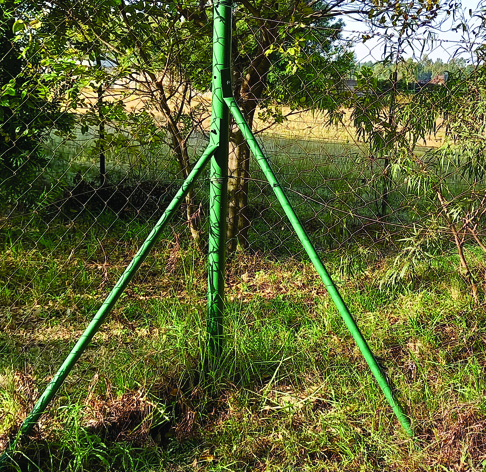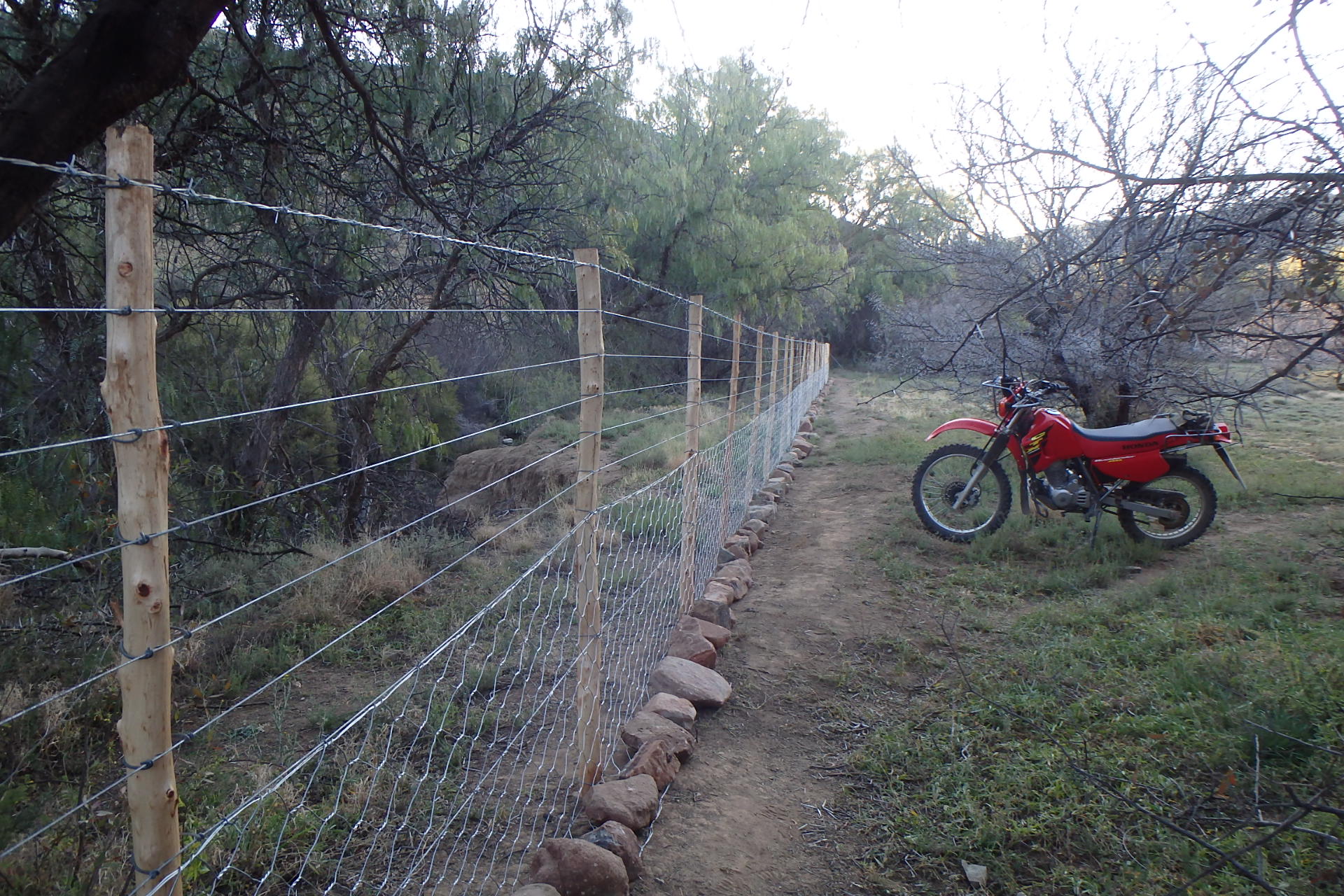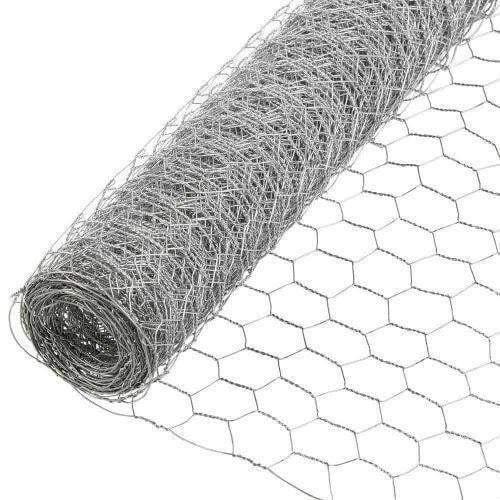A smallholding that is home to livestock requires adequate fencing to ensure your livestock are safe and secure. This fencing must keep both your livestock in, and unwanted ~ usually criminal but also predatory ~ elements out. But, fencing is not a one-size-fits-all for livestock and will differ according the type of animal, size of the herd and size of the property.
Basic terminology for wire fences
A post is a solid wooden pole or, more commonly, a hollow steel tube, which is placed vertically into the ground. It might also be made of concrete or, in some rural areas with abundant stone, of hewn rock.
A straining post is a strong post which is used to hold the tension in the main horizontal wires. When it is placed at a corner it is called a corner post. They are usually 10cm in diameter.
A gate post is a strong post to which a gate will be attached.
In long fences posts are also placed every 20m or so to provide additional strength and rigidity.
Posts are usually set in concrete foundations for added strength.
A steel post will, if properly made, have a square steel plate welded to its bottom to ensure a strong foot in the concrete , and a rounded cap welded to its top to prevent rainwater from accumulating in the post, and also to prevent the post from becoming a home to vermin.
A stay is a thinner post set at an angle to the upright corner post or straining post, to ensure that the tension in the horizontal wire does not pull the post out of the perpendicular. There is an art to setting a stay correctly in relation to the vertical pole. Set too high and its angle to the ground will be such that it is unable to perform its function properly and the whole assembly can simply pull out of the tension on the wires is sufficient. Set too low and it simply becomes a fulcrum over which the upright is pulled out of the ground.

In some cases, particularly where wooden posts are abundant, treated timber is used to manufacture a more traditional square “stay”. In this construction two posts are sunk, namely the corner post and a shorter vertical about 2m away. Between the post and the shorter vertical a further horizontal post is fastened, to keep the two apart. Finally, diagonal wires are strung in the shape of an “X” between the two posts, and tightly tensioned.
A standard is an intermediate post which is used to maintain the height and rigidity of the fence. They are usually made of steel and they also go into the ground. In South Africa two common types are found, the older “Iscor” profile, which has the shape of a mini railway rail, and the newer “Y”-standards which have notches on all three arms which hold both the horizontal wires and their bindings tightly in position.
A dropper is another intermediate item which is not fastened to the ground. Its purpose is also to maintain the height and rigidity of the fence, but they are important in preventing wires from pulling apart (and leaving a gap through which humans can climb) or preventing the fence from flopping. They are thinner and can be made of steel, wood or even bamboo. See also our accompanying article on making your own from scrap wire.
Galvanized wire is wire that has been coated in zinc, which protects wire and metal products from rust. Two types are used in fencing: high-tensile wire, which is oval in profile, and difficult to bend and cut and which can be tensioned to a considerable degree without snapping, and mild steel wire, which is round in profile and easier to work with, but which will snap under high-tension.
Barbed wire comes in a number of forms, and there are even collectors’ clubs that amass short lengths of barbed wire from different countries, regions and historical periods.
Currently in South Africa, variations of new barbed wire are single or double strand, where the two strands are twisted around one another, and single or double barbed. Each variation has benefits in terms of strength and ease of use, and implications in terms of cost.
Cattle
When building paddocks for your cattle, identify the location where you wish your cattle to be. Once identified, you can choose the placement of your straining posts. For cattle ~ who will require large paddocks due to their size ~ straining posts should not be more than 500m apart. If your land is not flat, putting straining posts on a hill or crest will make them easier to strain the fence over, and ensure that the strands are evenly heighted throughout. If there is no straining post in parts of your land that dip, you must ensure you fill the gap under the fence. You can use rocks for this.
Standards for cattle can be between twelve and 16m apart. If you are using 12m between standards, you will only need three droppers between standards. A minimum of 1.2m height for your fence is advised for cattle, using five strands of galvanised wire evenly spaced. You can use barbed or smooth wire. Barbed wire has a better grip on the droppers and will stop them sliding. Although cattle do not seem to be deterred by barbed wire, they can injure themselves when pushing through or against the wire, so be aware of this is rearing cattle for their leather hide.
Sheep
Fences to keep sheep constrained do not have to be as high as those for cattle. Typically, a hinged joint field fence is suitable for sheep. In South Africa, this is commonly referred to by the trade name Bonnox, or Veldspan, however there are many manufacturers of field fence mesh. This mesh comes in rolls typically of one to 1.5m heights. The mesh comprises horizontal straining wires and vertical stay wires typically 15-20cm apart. The number of horizontal strands can vary, with some fences have the lower strands very much closer than the upper strands.
Barbed wire is not recommended for sheep as their wool can get stuck and bunch up on the barbs. But, if you choose to use barbed wire your fences should contain at least five to six wires, and preferably eight to ten closely-spaced wires with closely-spaced verticals, both standards and especially droppers. Diamond mesh fencing can also be used for sheep. However it is more expensive so depending on the size of your field or paddock, this might not be financially feasible.
Goats
Because they are well-known as escape artists, fencing for goats needs to be well thought out. Eastern Cape Boergoat farmer Johann Steyn recommends a proven combination for a goat-proof fence. Over a 1,2m high eight-strand barbed wire fence he lays 90mm-high jackal fencing, burying the bottom under a line of boulders along the base of the fence. Jackal fencing is similar to common field fence, only with a thicker, stronger wire strand and smaller aperture. In smaller camps designed to contain very small kids and their lactating mothers Steyn uses the smallest aperture jackal-fencing he can find, saying that if the aperture is too large the kids push their heads through and can’t get back out.

Horses
Fencing for horses should be at least 1.4m high but higher ~ up to 1.8m ~ is highly recommended. Your lowest strand should be at least 30cm off the ground. This will prevent horses putting their hooves through the fence and injuring themselves and damaging your fence. Openings between your horizontal strands should not be big enough for a horse to fit its head through. Visibility is important for horses ~ attach PVC piping along your fence or a piece of wood painted white. This will help if your horse is startled and attempts to escape.
A much better alternative for equine fencing is wooden post and rail. It is more expensive, but much smarter.
Poultry and waterfowl
When building chicken coops or houses, chicken mesh will be your ultimate solution. This is a braided, hexagonal galvanised steel mesh with openings usually ranging from 1cm to 9cm wide. Wire strand thicknesses vary in chicken mesh. This is a lightweight product and should be reinforced well with your fence frame. Thicker meshes, such as a welded diamond mesh, are also suitable for poultry but are heavier, more expansive and harder to work with.

This is recommended for permanent structures, where traditional chicken mesh can be easily manipulated and adjusted without much effort on your part. When buying mesh for birds, pay close attention to the size of the opening against the size of the bird you are keeping. If you intend to breed, and therefore will have chicks, go for the smallest opening you can find ~ chicken mesh is manufactured as small as a 1.3cm width hexagonal design.
Main image: Bonnox or Veldspan.

